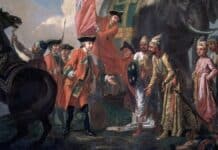The Kalinga War fought in the 3rd century BCE, holds a significant place in the annals of ancient Indian history. It was a watershed moment that transformed the ambitious Emperor Ashoka and the Mauryan Empire itself. This war is one of the most well-known conflicts in Indian history and one of the bloodiest conflicts in world history. This article delves into the events leading up to the Kalinga war, and its profound consequences. By examining the impact of the Kalinga War, we can gain insights into the complexities of power, conquest, and the enduring quest for peace.
Contents
Historical Background
Before we delve into the Kalinga War, it is crucial to understand the historical context in which it took place. Ashoka, the third emperor of the Mauryan dynasty, had embarked on a relentless military campaign to expand his empire. By the time the Kalinga War occurred, Ashoka had already conquered vast territories, extending his domain across much of modern-day India. However, Kalinga, a prosperous region located on the eastern coast, remained independent, and its autonomy posed a challenge to Ashoka’s authority.
Region of Kalinga
Kalinga was East-central India’s historic territorial division. It corresponds to modern-day Madhya Pradesh, the majority of Odisha, northern Telangana, and northeastern Andhra Pradesh. According to strict definitions, Kalinga did not extend south of the Godavari River, omitting Vengi (the territory between that river and the Krishna River). The hinterland of the area is connected to central India and the Indo-Gangetic Plain to the north by a hilly, heavily wooded region. Kalinga had a thriving seaborne trade with Burma (now Myanmar) and regions even farther south and east to the ports of Kakinada, Visakhapatnam, and Srikakulam (Chicacole), as well as the significant cities of Rajahmundry and Vizianagaram, all of which are now in Andhra Pradesh.
Mahapadma, who established the Nanda dynasty in Magadha (c. 343–c. 321 BCE), invaded Kalinga. It broke away from the Magadhan empire shortly after the end of the Nanda dynasty, although it was later retaken by Ashoka, the Mauryan ruler, in the third century BCE after a bloody battle that is said to have influenced him to become a Buddhist. The Yayatis, Vishnukundins, Bhanjas, and Bhauma Karas later governed some of the coastal strips, as did the Somavamshis of southern Kosala, who controlled the important town of Chakrakotta (in what is now southern Chhattisgarh).
The most well-known kings in all of Kalinga were the Eastern Gangas. Their dynasty, which came to power in the middle of the 11th century CE, occasionally engaged in a rivalry with and occasionally formed alliances with the Eastern Chalukyas of Vengi. Anantavarman Chodnagagadeva was particularly well-known in the next century; he constructed the Jagannath Temple at Puri (now in eastern Odisha). The Eastern Gangas took care of watching over that time and considered the deity as their landowner. Narasimha constructed the well-known sun temple at Konark in the 13th century. The Eastern Gangas successfully resisted Muslim invasion from the north between 1238 and 1305, but the dynasty fell in 1324 when the ruler of Delhi invaded Kalinga from the south.
Kalinga War
The Kalinga War, which took place between Ashoka, the great Mauryan Emperor, and the ruler of the State of Kalinga, a feudal republic located in modern-day Odisha and northern Andhra Pradesh, is one of the most well-known conflicts in Indian history and one of the bloodiest conflicts in world history.
Causes of the Kalinga War?
The Kalinga War was primarily driven by a combination of strategic, economic, and political factors. Several causes contributed to Emperor Ashoka’s decision to wage war against the independent kingdom of Kalinga.
- Expansionist Ambitions: Ashoka, like many rulers of his time, had a strong desire to expand his empire and consolidate his authority. By the time of the Kalinga War, Ashoka had already conquered large parts of the Indian subcontinent. Kalinga’s independence and its strategic location on the eastern coast posed a challenge to Ashoka’s vision of a unified empire. The desire to exert control and extend his dominion motivated Ashoka to pursue military action against Kalinga.
- Wealth and Resources: Kalinga was known for its prosperity and abundant resources. The region was a hub of maritime trade, with access to valuable commodities such as spices, precious metals, and gemstones. The economic potential of Kalinga was a significant factor in Ashoka’s decision to wage war. By bringing Kalinga under his rule, Ashoka aimed to control its wealth and resources, further enhancing the economic power of his empire.
- Maritime Power: Kalinga had a reputation as a formidable maritime power in ancient India. It’s skilled sailors and extensive naval capabilities made it a force to be reckoned with in the Indian Ocean trade network. Ashoka, intrigued by Kalinga’s maritime prowess, saw the conquest of Kalinga as an opportunity to expand his influence and control over maritime trade routes. Gaining dominance over Kalinga would solidify Ashoka’s control over both land and sea, increasing his empire’s strategic and economic advantages.
- Failed Diplomatic Attempts: Prior to the outbreak of the war, Ashoka made diplomatic efforts to peacefully annex Kalinga. However, these attempts proved unsuccessful, as Kalinga fiercely resisted subjugation. The failure of diplomatic negotiations pushed Ashoka toward military action as a means to achieve his objectives. The reluctance of Kalinga to surrender its independence and the perceived defiance of Ashoka’s authority further fueled his determination to conquer the kingdom.
- Symbolic Suppression: The conquest of Kalinga was not only a strategic and economic objective for Ashoka but also a symbolic display of his power and authority. Kalinga’s resistance and independence were seen as a challenge to Ashoka’s sovereignty. Subduing Kalinga would serve as a demonstration of his military might and establish his dominance over any opposition within his empire. The symbolic significance of conquering Kalinga played a crucial role in Ashoka’s decision to wage war.
In summary, the causes of the Kalinga War can be attributed to Ashoka’s expansionist ambitions, the allure of Kalinga’s wealth and resources, the kingdom’s reputation as a maritime power, failed diplomatic negotiations, and the symbolic suppression of a defiant kingdom. These factors converged to drive Ashoka toward military action, ultimately leading to the brutal conflict that transformed both Ashoka and the course of ancient Indian history.
Rationale and Prelude to War
Ashoka’s desire to subjugate Kalinga was fueled by both strategic and economic considerations. The region was renowned for its wealth, seafaring trade, and resources. Moreover, Kalinga’s fierce reputation as a maritime power intrigued Ashoka, who sought to expand his dominion over the entirety of the Indian subcontinent. Consequently, diplomatic attempts to peacefully annex Kalinga failed, and the stage was set for a war.
Type of Weapons Used in the Kalinga War
During the time of the Kalinga War in the 3rd century BCE, various weapons and military technologies were employed by both the Mauryan Empire, led by Emperor Ashoka, and the kingdom of Kalinga. While the exact details of the weaponry used in the war are not extensively documented, historical accounts and archaeological findings provide insights into the types of weapons commonly employed during that period. Those are follows.
Melee Weapons
- Swords: Swords were a primary weapon used by infantry soldiers. They were typically made of iron or steel and varied in length and design, including curved and straight blades.
- Spears: Spears were long, thrusting weapons with pointed tips. They were effective for both offense and defense, allowing soldiers to engage enemies from a distance.
- Axes: Battle axes were heavy cutting weapons used for close combat. They had a wide, crescent-shaped blade mounted on a long wooden handle.
- Maces: Maces were blunt weapons with a weighted head made of metal or stone. They were designed to deliver crushing blows to armored opponents.
- Clubs: Clubs were simple yet effective weapons, consisting of a solid wooden or metal shaft used to strike opponents.
Ranged Weapons
- Bows and Arrows: Archery played a crucial role in ancient warfare. Bows were typically made of wood, and arrows were tipped with metal points. Skilled archers provided long-range support and could rain down arrows on the enemy.
- Slings: Slings were used as a projectile weapon. Soldiers would swing a sling attached to a cord and release it to hurl stones or lead bullets at the enemy.
- Javelins: Javelins were thrown spears, designed for short to medium-range attacks. They were effective in disrupting enemy formations and could be hurled with accuracy.
Siege Weapons
- Catapults: Various types of catapults, such as traction trebuchets and ballistae, were employed for siege warfare. These machines were capable of launching large projectiles or stones at fortifications to breach or weaken defenses.
- Battering Rams: Battering rams were used to break down gates and walls of fortified structures. They consisted of a heavy beam mounted on wheels and were pushed or swung repeatedly against the target.
Defensive Equipment
- Shields: Soldiers used shields made of wood or metal to protect themselves from projectiles and melee attacks.
- Armor: Soldiers and officers wore different types of armor, including leather, chainmail, and metal plates, to protect their bodies from weapons.
- Helmets: Helmets provided protection for the head, often made of metal and designed to shield against strikes.
It’s important to note that the specific design and composition of weapons might have varied across different regions and armies during the Kalinga War. The availability of resources, technological advancements, and regional preferences could have influenced the types of weapons utilized in combat.
The brutality of the Kalinga War
The Kalinga War fought in 261 BCE, witnessed a massive clash between the Mauryan army and the forces of Kalinga. Ashoka’s military might be overwhelming, with his well-trained soldiers and superior resources, and advanced weapons. However, Kalinga fiercely resisted the onslaught, displaying remarkable courage and resilience. The battle was characterized by extreme brutality, with both sides suffering heavy casualties.
Ashoka’s Transformation
The horrors witnessed during the Kalinga War had a profound impact on Emperor Ashoka. He was deeply moved by the carnage and destruction he had caused, leading to a profound change of heart. Ashoka, known for his previously expansionist policies, suddenly renounced violence and embraced the path of non-violence and compassion. His remorse over the loss of life and suffering prompted him to adopt Buddhism, which became the guiding philosophy of his reign.
Ashoka established a secret society
According to some resources, after the Kalinga War, Ashoka established a secret society called the “Nine Unknown Men” tasked with safeguarding and preserving knowledge that could be misused if it fell into the wrong hands.
The legend suggests that each of the Nine Unknown Men was assigned a specific area of knowledge, such as physics, medicine, psychology, and more. They were responsible for developing and protecting advancements in their respective fields. It is said that these individuals operated in secrecy, sharing their knowledge only among themselves and passing it down from generation to generation.
While the tale of the Nine Unknown Men is intriguing and has captured the imagination of many, it is important to approach it with skepticism. There is no concrete historical evidence or documentation from Ashoka’s time that verifies the existence of such a society. The legend likely originated from works of fiction or speculation over the centuries.
It’s worth noting that Emperor Ashoka did indeed promote knowledge, philosophy, and intellectual pursuits during his reign. He supported the spread of Buddhism, established universities, and patronized scholars and thinkers. However, the specific notion of the Nine Unknown Men is not substantiated by historical records and should be regarded as a fascinating legend rather than a verifiable historical fact.
Consequences and Legacy
The aftermath of the Kalinga War was marked by Ashoka’s ambitious efforts to atone for his past actions. He initiated a series of measures aimed at fostering peace, promoting ethical governance, and spreading Buddhist principles throughout his empire. Ashoka’s rock edicts, inscribed on pillars and walls across his domain, served as a testament to his newfound commitment to non-violence, religious tolerance, and social welfare.
Furthermore, Ashoka’s transformation and the subsequent propagation of Buddhism played a pivotal role in the spread of the religion beyond India’s shores. Ashoka’s missionaries traveled far and wide, disseminating Buddhist teachings throughout Asia, including Sri Lanka and Central Asia.
Conclusion
The Kalinga War stands as a stark reminder of the brutality of war and its consequences. While it unleashed untold suffering and devastation, it also acted as a catalyst for Emperor Ashoka’s transformation and the adoption of a more humane and enlightened approach to governance. The lessons learned from the Kalinga War continue to resonate, highlighting the potential for personal and societal growth, even in the face of immense bloodshed. Ultimately, the Kalinga War serves as a turning point in ancient Indian history, shaping the trajectory of the Mauryan Empire and leaving behind a lasting legacy of peace and compassion.
Ashoka’s transformation following the Kalinga War stands as a testament to the power of empathy and introspection. His conversion to Buddhism and subsequent commitment to non-violence became the guiding principles of his reign. Ashoka’s rule became synonymous with the promotion of social welfare and religious tolerance. He implemented a series of policies aimed at improving the lives of his subjects, establishing hospitals, building roads, and promoting trade and agriculture.
One of Ashoka’s most notable contributions was the rock edicts, inscriptions carved into pillars and walls, which conveyed his teachings and principles to the masses. These edicts emphasized the importance of moral conduct, tolerance, and respect for all religious beliefs. Ashoka’s efforts to spread Buddhism extended far beyond his empire, as his missionaries embarked on journeys to neighboring regions, playing a pivotal role in the dissemination of Buddhist philosophy.
The impact of the Kalinga War and Ashoka’s transformation went beyond the boundaries of his empire. It influenced neighboring kingdoms and set a precedent for peaceful coexistence and diplomacy. Ashoka actively sought alliances and engaged in diplomatic exchanges with foreign powers, fostering a climate of harmony and mutual respect.
The legacy of Ashoka and the Kalinga War endured long after the decline of the Mauryan Empire. Ashoka’s principles and teachings continued to inspire generations of rulers and thinkers, both in India and beyond. His model of compassionate governance and commitment to social welfare left an indelible mark on the collective consciousness of ancient India.
Furthermore, the spread of Buddhism, fueled by Ashoka’s conversion and missionary efforts, shaped the cultural and religious landscape of Asia. Buddhist teachings found fertile ground in various regions, influencing art, architecture, and social structures. The Mauryan Empire’s impact on Buddhism’s growth and expansion cannot be overstated.
In conclusion, the Kalinga War was a pivotal event in ancient Indian history, marking a turning point in Emperor Ashoka’s life and the trajectory of the Mauryan Empire. The war’s brutality and the subsequent remorse experienced by Ashoka led to a profound transformation that shaped his reign and the principles he propagated. Ashoka’s conversion to Buddhism and his commitment to non-violence and social welfare left an enduring legacy of peace and compassion. The lessons learned from the Kalinga War continue to resonate, reminding us of the profound capacity for personal and societal growth, even in the face of tragedy and conflict.
Sources
- Ray, H. P. (2020). The Mauryan Empire. The Oxford World History of Empire: Volume Two: The History of Empires, 198.
- Chakravarti, R. (2016). Mauryan Empire. The Encyclopedia of Empire, 1-7.
- Indira Gandhi National Centre for the Arts. (n.d.). Age of the Nandas and Mauryas (K. a. N. Shastri, Ed.).
- Samrat, M. Ashoka The Great.
- Mohanty, B., & Jena, I. (2014). Kalinga, Kalinga and Kalinga. Editor’s Note, 36.
- Radhakumud Mookerji (1988). Chandragupta Maurya and His Times. Motilal Banarsidass Publ. ISBN 81-208-0405-8.
- Sastri, K. A. Nilakanta (Ed.). (1967). The Cambridge History of India: The Mauryan Empire. Cambridge University Press.
- Sen, Sailendra Nath. (2010). Ancient Indian History and Civilization. New Age International.
- Singh, Upinder. (2008). A History of Ancient and Early Medieval India: From the Stone Age to the 12th Century. Pearson Education India.
- Roy, Kaushik (Ed.). (2015). Ancient Warfare in South Asia: The Impact of the Mauryan Empire. Routledge.
- Roy, K. (2015). Military Manpower, Armies and Warfare in South Asia. Warfare, Society and Culture. Taylor & Francis. p. 16. ISBN 978-1-317-32128-6.
- Allen, Charles (2012). Ashoka: The Search for India’s Lost Emperor. Little, Brown Book Group. p. 82. ISBN 9781408703885.
FACT CHECK: We strive for accuracy and fairness. But if you see something that doesn’t look right, please Contact us.
DISCLOSURE: This Article may contain affiliate links and Sponsored ads, to know more please read our Privacy Policy.
Stay Updated: Follow our WhatsApp Channel and Telegram Channel.












